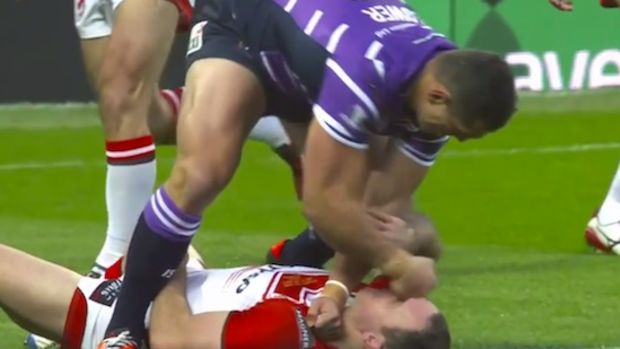GERREMONSIDE! When Rugby League Was The King Of Sports
Men who lifted concrete paving slabs on a weekday and drove taxis through battle scarred city centres on a night. Men with what your Dads would have called “proper jobs.” And as well as putting in a solid weeks graft on the factory floor or the building site, they spent their only day off getting their heads stamped into a freezing lake of mud. They didn’t do it for the money and they didn’t even really do it for love. These were men who were born into the North Of England for a specific and divine purpose; to spend their Sabbath re-enacting that most primeval of pagan rituals - the holy game of Rugby League.
Back in the eighties, a Sunday afternoon watching thirteen a side was a much different experience to the sanitised sporting day enjoyed by modern day crowds. There were no cheerleaders, no sponsored stadiums and no Australian coaches with their “tactics” and “sliding defences” - just a rain battered open field with a corrugated iron roof and some big hairy arsed docker pissing the residue of last night’s bitter down the back of your leg. Back then, as now, RL was a family game. Although the families that attended grounds such as Wilderspool, Odsal and The Boulevard made the Addams Family look like the Vonn Trapps. In marked contrast to the Italian sportswear and designer wedge haircuts of the eighties football terraces, the average Rugby League Kop End was a sea of Freeman catalogue jeans, terrifying facial tattoos and egg stained scarves. Grubby infant delinquents pelted hapless shivering touch judges with half eaten pies and red faced Nana’s turned the air blue, waving their meaty fists at the ref, screaming at him to “gerremonside!”
On the pitch, we were treated to brain battering brawn and balletic brilliance in equal measures. For the ultimate in skill, speed and psychosis, the dream Rugby League line up would have looked something like this:
At full back, Paul Woods. A Welshman with the heart of a lion and the face of a pit-bull, “Psycho” Woods was like a kamikaze pilot crossed with Captain Caveman, hurling himself enthusiastically into the paths of stampeding giants without a thought for personal safety. He was also loved the needle of a good grudge match. In one local Hull Derby, Woods was engaged in a running battle with the opposing scrum half who managed to inflict a nasty gash on Psycho’s leg with his studs. Woods retired to the touchline to have his bloody leg hastily bandaged. Noting his absence from the last line of defence, the scum half took the opportunity to chip the ball over, and went racing for the ball. Psycho made a bolt for him whilst his leg was still being bandaged; the bloody white bandage unravelling twenty foot behind him like a streamer. He leapt on his opponent and they went tumbling around in a blur of fists, studs and medical dressing.
More...
15 Sportsmen Who Have Tried Their Luck In Rugby League
A Tribute To Sean Long, Rugby Maverick And Incompetent Drunk
The wingers would have to be Henderson Gill and Des Drummond. Henderson started his career at Bradford but enjoyed the best days of his career in the all-conquering Wigan side of the mid eighties. He possessed a bewilderingly low centre of gravity which made him virtually impossible to knock over, and a sidestep that could send an entire team colliding into each other as he zigzagged through their defence, leaving the swiftest of opponents grabbing handfuls of empty air. The diminutive Des Drummond was simply Rugby League’s first Superstar and an automatic choice on the right wing for all the Great Britain teams of his era. Des’s speciality was a blistering burst of acceleration down the touchline followed by a spectacular swan dive at the corner flag. Des Drummond even appeared on the telly programme Superstars, a rare exposure for RL players at the time. He marked his appearance by feeding all other competitors a trail of dust and briefly almost made Rugby League marketable to the South of England.
Centres – Joe Lydon and James Leuluai. Joe was that Rugby League rarity, a handsome clean cut chap whose pop star good looks remain largely unblemished by a career being chased around by raging Neanderthals. It was his undoubted gazelle like pace that allowed him to escape serious punishment – that, and his natural evasiveness. A full flight Joe Lydon was more evasive than a politician in a live telly interview with Jeremy Paxman. Joe maintains a successful career these days as a RL pundit on TV, a role that seems to have fallen to him by default – he’s probably one of the only Rugby League veterans who’s face is suitable for public broadcast before the watershed.
By marked contrast, James Leuluai was blessed with a face that came with an 18 certificate. The New Zealand International may have had a visage that suggested he spent training sessions chasing parked cars, but what he lacked in movie star appeal he more than made up for in sheer physical prowess. Blessed with natural balance, speed and the tackling strength of a pack forward, Leuluai would the powerhouse counter-foil to Lydon’s poise and grace.
Half back pairing – Ellery Hanley and Andy Gregory. Before making the move into the pack and becoming both captain and loose forward for both his club and country, Ellery Hanley was a stand-off. And what a stand off! Hanley had the upper body strength of Mike Tyson, the graceful movement of Fred Astair, lightening speed of foot and thought, and was equipped with a natural rugby brain that seemed to control the play around him like telekinesis. Always able to find the extra yard of space or the impossible pass out of any tight corner, Hanley was quite simply the complete Rugby League Player.
At scrum half, Andy Gregory – like a Tetley Bitter fuelled Popeye, and the man BBC’s Ray French habitually referred to as “the lickle pocket backle ship”. What Andy lacked in vertical inches he made up for in sheer skill, guile and bravery. With his shirtsleeves rolled up to his shoulders and his little bandy legs whirring round like a Tasmanian Devil on an exercise bike, Gregory roved around the pitch like a demented gargoyle on PCP. The master of provocation, there was no finer sight on a Rugby League pitch than seeing Gregory leap three feet into the air to stick the nut on an opposing Australian’s knee. Andy made the headlines again a year or so ago when he fought off a twelve stone rottweiller by repeatedly punching it in the face. Without dropping his pint. A true Rugby League giant.
More...
Wigan v Hull 1985: The Greatest Challenge Cup Final Ever
5 Reasons Why Leeds Rhinos Are The Best Rugby League Team Ever
Front row – Kevin Ward, Eddie Szymala and Len Casey. Kevin Ward was probably the hardest rugby league player to never throw a punch in anger. An affable gentle giant off the pitch, the Yorkshire born prop forward could make an entire opposing front row shit their collective shorts with a thousand yard Yosser Hughes style stare. It was very rare that Kevin ever had to clout anyone – no one would have been daft enough to provoke him. At Hooker, Eddie Szymala was a wind-up merchant extraordinaire. Festooned with more tattoos than Robert De Niro out of Cape Fear, Szymala delighted in the sly dig and the fine art of verbal abuse. Loved by the people of Barrow and reviled by opposing fans everywhere in the North, Eddie was like a leary circus strongman, a permanent pain in the neck for referees. Prop Len Casey had a similar love/hate relationship with RL crowds in the 80’s. A pantomime villain on steroids, Casey was in possession of a black road sweepers tache and spectacularly bad temper, once famously barging over a referee who had the ill judgement to send him of for battering someone in a televised match.
Second Row – Phil Lowe and Mick Crane. Phil Lowe was one of the first British RL stars to win the respect of the famously sniffy Australian press and players, battering them all around Wembley when the Aussies toured here in 1973. Phil was a giant of a man in all senses of the word, a naturally skilled match winner and a keen exponent of the art of steamrolling would be tacklers. In retirement he remains a great ambassador for the old fashioned values of the game, and has also kept the up the other grand tradition of the retired player by owning not one but four pubs in the Hull region.
Mick Crane was not the most physical of forwards, but possessed an amazing array of passes, strolling casually round the pitch and slinging the ball around at impossible angles. Often the provider of tries for his team mates, Mick once surprised himself by dummying his way through an entire Salford defence at The Boulevard and getting his name on the score sheet. So exhausted was he by this spurt of activity that he jogged over to the cheering Threepenny Stand and asked a bloke leaning at the front barrier for a drag on his cig. Suitably refreshed by a lungful of Benny Henny, Mick strolled back and converted the try. The Jack Duckworth of Rugby League, Mick spent most of his off-field time donating money to sick animals, especially dogs and horses. Mick could often be found in various charitable establishments, tearing up little slips of paper and dragging furiously on an Embassy as his latest equine or canine interest stumbled dramatically at the final bend.
The number 13 journey would have to go to the legendary Steve “Knocker” Norton.
If Knocker had been a car, he’d have been a bright red Ford Capri with yellow flames up the side and a horn that played the theme tune to Hawaii Five-O. He had a head like a badly dented watering can and hands like two knuckles of ham - but with the oval ball in his hands he was a beautiful force of nature. Defence splitting passes, a bewildering array of chips, kicks and punts, more slight of hand than Paul Daniels – it was like Knocker had the oval ball under a spell and he could make it swoop, swirl and slide around the pitch like a mud spattered magician.
And that’s the ultimate Eighties Rugby League Line Up – a head-spinning blend of flair, brutality and beer soaked charisma.
Rugby League may have become the sleek sanitised and media-friendly sport we see on our digi-screens today, but it’s beating heart will always be in a bucket of sand somewhere on a freezing mud-lake in Whitehaven in 1982.


